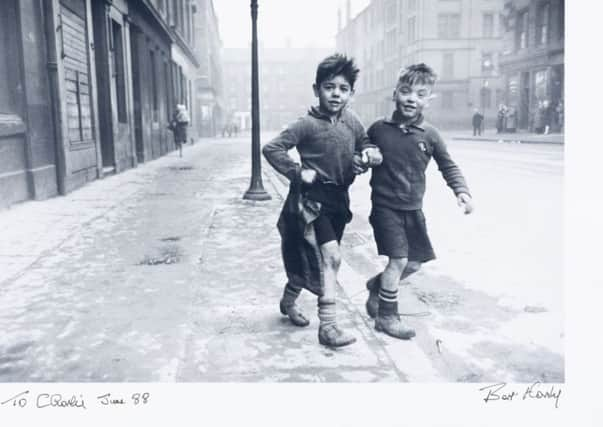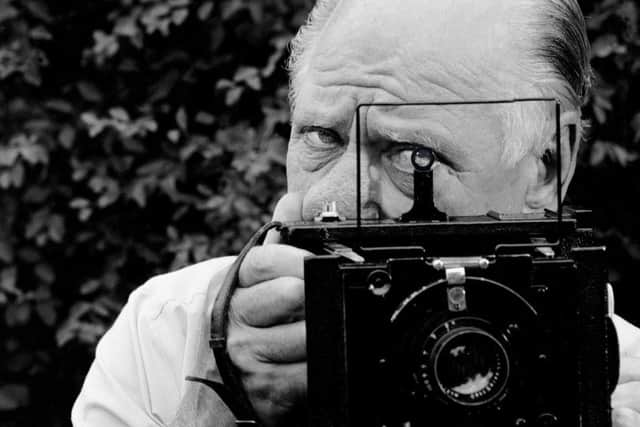Iconic image of Glasgow goes under hammer


Now, a famous image of two young boys in one of the city’s notorious slums, taken by the esteemed documentary and press photographer, Bert Hardy, is to go under the hammer.
“The Gorbals”, a stark black- and-white photograph, was taken by Hardy in 1948, a time when thousands of families were living in squalid tenement blocks.
Advertisement
Hide AdAdvertisement
Hide AdThe image captures two young boys in tatty clothing playing in a street in the area to the south of the River Clyde, surrounded by the dilapidated, overcrowded housing stock.


Hardy had been sent to Glasgow by his employers, the Picture Post, a prominent photo-journalistic magazine which ran from 1938 to 1957, echoing the tone and content of Life, the long-running US publication.
Intrigued by the Gorbals’ unwanted reputation as being among the worst slums in all of Europe, the London-born photographer captured the decay, but also something of the city’s spirit – the youngsters in his frame are walking arm in arm along the long demolished Clelland Street, wearing cheery smiles.
Indeed, despite being one of the first photographers to enter the liberated Belsen, and a career which saw him travel as far afield as Tibet, the picture he took in Glasgow – one syndicated and reproduced around the world – remained his most cherished work.
“It’s my favourite picture,” he would later reflect. “It reminds me of what I was like when I was a kid. In this story I concentrated on the children, and how they kept their spirits up in conditions which were often dreadful.”
The two young boys, then aged around seven, were later identified as Les Mason and his friend George Davis. Both went on to work in the Clyde shipyards. Mason died in 2011 at the age of 70 while Davis died in 2002 aged 61.
The former’s family said Mason had not been aware it was him in Hardy’s photograph until the 1980s, but that he felt proud of his link with Glasgow’s past.
Hardy, whose work continues to be exhibited around the world, always maintained that he became a photographer by accident. His first best-selling picture was taken with an old plate camera in 1936, when he captured an image of George V and Queen Mary passing through a London street during the Silver Jubilee celebrations.
Advertisement
Hide AdAdvertisement
Hide AdAn enterprising young Hardy printed up 200 postcards of the picture, selling them for 6d apiece. He died in 1995 at the age of 82.
More than 70 years after his Gorbals image was captured for posterity, it is among a clutch of photographs by Hardy that will be sold next month by Gildings Auctioneers, situated in Market Harborough, near Leicester.
The photograph comes from the family collection of Hardy’s personal developer, Charles Keeble, who honed his skills at the Picture Post darkroom.
Will Gilding, director and specialist of 20th century sales at the East Midlands auction house, said: “To many people the name Bert Hardy won’t mean anything, but show them one of his most famous photographs from the late 1940s and the response will be entirely different.
This is because Hardy was a photographer who worked for Picture Post magazine during the Second World War through to the late 1950s, and during that time he captured his trademark stark and evocative images of the struggles of inner city life.
“This proves to be such a powerful image from this pivotal moment in British history. It was so powerful that Hardy himself reflected that it was his favourite picture.”
The auction, on 2 December, also includes work by photographers such as Thurston Hopkins, Tim Gidal, and John Chillingworth, all of whom worked alongside Hardy at the Picture Post in the mid 20th century.
Gilding added: “Photography is a very exciting area of the art market at present, and this collection offers buyers the chance to acquire very strong 20th century images from as little as £100 up to potentially £1,000 for the more iconic photographs.
“There are some very powerful images here, often forcing us to reflect on dark troubled days, but all capturing the warmth and the inherent hope of humanity.”